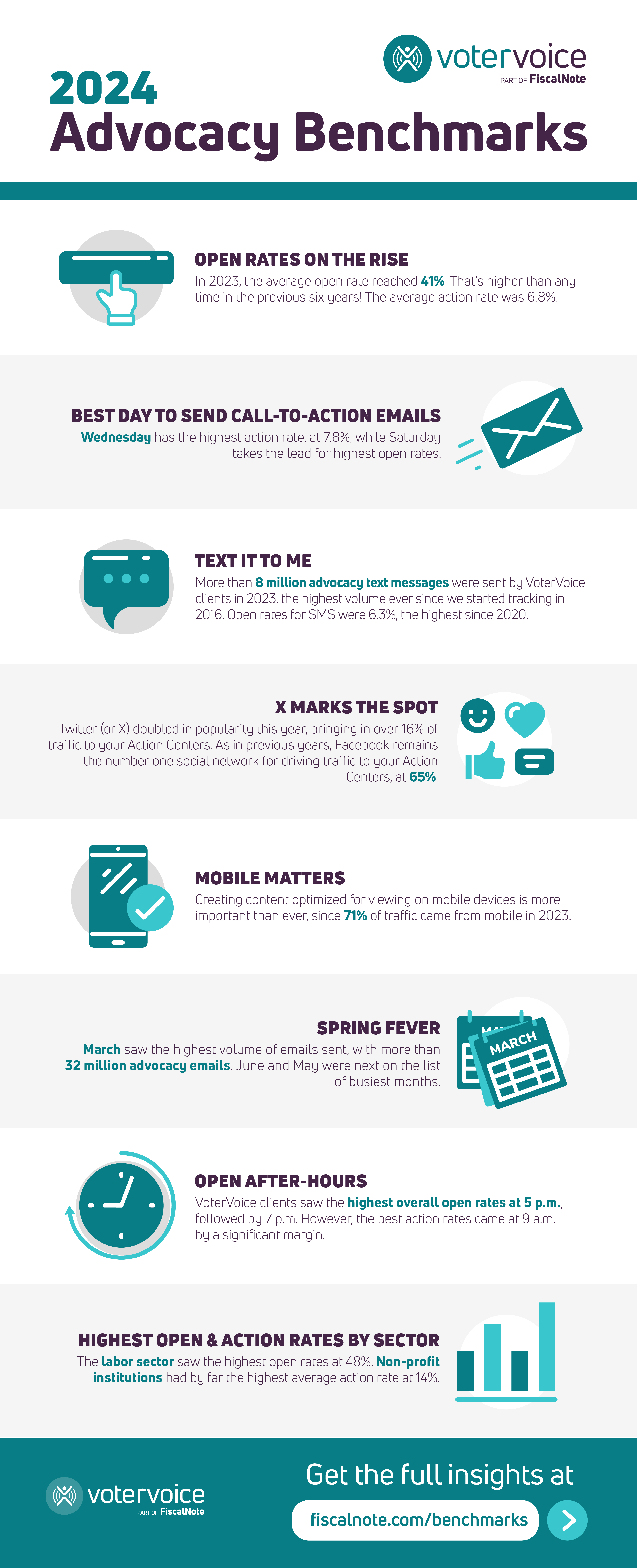 Great email advocacy campaigns don’t happen by themselves, but they’re a huge part of advocacy professionals’ jobs. Organizations rely on email to create awareness for their issues, reach their supporters, ask for donations, and inspire them to mobilize and take action to move the needle on key legislation and regulations.
Great email advocacy campaigns don’t happen by themselves, but they’re a huge part of advocacy professionals’ jobs. Organizations rely on email to create awareness for their issues, reach their supporters, ask for donations, and inspire them to mobilize and take action to move the needle on key legislation and regulations.
But the truth is that the average person gets more than 120 emails a day, and a good percentage of those have an “ask” — buy this, read that, take action. If you’re serious about getting your members or advocates engaged, you need to be systematic about the email advocacy component of your campaign.
How to Increase Email Advocacy Engagement
Almost daily, our advocacy clients ask us what sort of benchmarking rates they should be comparing themselves to. Our FiscalNote data science team analyzed 559 million emails sent from our advocacy tools to build our 2024 Advocacy Benchmark Report so we know a thing or two about successful email advocacy campaigns. Here, we bring you some of the best practices we’ve learned from working with 2,000+ organizations running frequent advocacy campaigns:
CHOOSE AN ENGAGING SUBJECT LINE
You have 30 seconds to make an impression at a job interview. Your email subject line has less than two. In those two seconds, your recipient has also scanned the subject lines of another five emails. Needless to say, you should be spending some time perfecting your subject line.
In doing so, remember these five tips:
- Be brief — keep it under 40 characters
- Add a metric — numbers help quantify value and resonate with people
- Get to the point — be direct in what you need from your recipients
- Add a consequence for not acting
- Give a timeline — help convey the sense of urgency
INCLUDE A CLEAR CALL TO ACTION
Once you get people to open your advocacy email, the call to action is the next most important piece to work on. Whatever it is, it’s an ask that will eat up some of their valuable minutes, so spend some time considering how it will look to the reader.
Be clear about the action you want the advocate to take, and use the words that describe the specific action; for example: sign the petition, make a donation, send a tweet or email, etc.
RUN TESTS BY SEGMENTING YOUR AUDIENCE
Slicing and dicing your email database list, and using data you already have about your members to create smaller subgroups, lets you hone your advocacy email message. That allows you to craft more targeted, relevant emails, which will help increase your campaign results.
Be it by the level of engagement or affinity to a specific issue, segmenting your list and tweaking your message for each can go a long way in boosting engagement with your advocacy emails and lowering unsubscribe rates.
FOCUS MORE ON ENGAGEMENT THAN OVERALL NUMBERS
While you want to always make sure you are growing your lists and educating a larger number of people about your issues, sometimes in email advocacy, quality is better than quantity. If you have a large list of unengaged supporters, that can throw off all your benchmarks.
Keep good list hygiene and make sure to remove from your main communications those who haven’t engaged with your advocacy emails in the last six months to a year if you’ve been sending regular communications. This is an important practice to be able to really understand who your supporters are and how you can better target them.
OPTIMIZE LAYOUT FOR MOBILE
In our 2024 Advocacy Benchmark Report, we found that 71 percent of traffic to our clients’ action centers came from mobile devices.
You should be creating and testing your advocacy emails (including your subject lines) for mobile viewing first.
STICK TO YOUR ORGANIZATION’S PURPOSE
 Always link your advocacy email messages to your overall organization’s mission and goals. People join — and stay in — organizations that speak to their needs, deliver relevant information, and connect them to opportunities for meaningful involvement.
Always link your advocacy email messages to your overall organization’s mission and goals. People join — and stay in — organizations that speak to their needs, deliver relevant information, and connect them to opportunities for meaningful involvement.
Your message should be concise and clearly linked to your organization’s core values. Avoid flowery language and highly detailed specifics about the legislation. Focus on their specific pain point or the consequence your request will help with, and tell them the impact their action (or non-action) will have.
AVOID ACRONYMS AND INDUSTRY JARGON
Even if you’re in a specialized industry, make sure you use language that empowers your advocates to share with others even outside their industry to help widen your influence. You work in government relations, they don’t — so keep it simple.
Email Advocacy Benchmarks
OPEN RATE
The open rate is the percentage of recipients who received your emails in their inboxes and opened them, regardless of whether they had a call-to-action or not.
- Open rate benchmark: 41.7 percent
ACTION RATE
This is the percentage of recipients who opened your call-to-action emails and followed through by taking the action you requested of them.
- Action rate benchmark: 6.8 percent
UNSUBSCRIBE RATE
This metric refers to the number of people who saw your email in their inbox and decided its content wasn’t relevant to them, so they asked to be taken off your email list.
- Unsubscribe rate benchmark: 0.1 percent
These are overall benchmarks, but they can vary by industry. We do a deep dive into 17 sectors and 50 industries in our report.
Finding the Best Time to Send Your Email Advocacy Campaigns
 Identifying the best day/time combination for your advocacy campaigns to get the most engagement from your supporters is more an art than a science. However, we want to make it a bit easier for you to find those pockets of opportunity where advocates are more tuned in and willing to take action.
Identifying the best day/time combination for your advocacy campaigns to get the most engagement from your supporters is more an art than a science. However, we want to make it a bit easier for you to find those pockets of opportunity where advocates are more tuned in and willing to take action.
That’s why we leveraged the data from the more than 28,000 advocacy campaigns from our clients to build our annual Best Day/Time Matrix for Advocacy Email Campaigns. We combined the open and action rates per day and per hour to identify the day/time combinations where our VoterVoice clients found the most engagement. Use this matrix and quickly find what time and day combination could yield the best engagement from your audience and start testing!
Examples of Successful Email Advocacy Campaigns
LARGE-SCALE ADVOCACY CAMPAIGN
Late in the summer of 2021, an IRS provision surfaced in the Build Back Better Act (BBBA) that required credit unions and other financial institutions to report information on inflows and outflows of greater than $600. The proposal required depository institutions to report nontaxable activity, which would create a significant compliance burden for credit unions.
The Credit Union National Association (CUNA) team launched an email campaign mobilizing members and had more than 850,000 sent to Congress.
“We did a lot of emails to our members, we placed the action alert in a lot of our news stories like our daily email publications, and we had messages go out from our chief advocacy officer to large groups of people,” said Kristen Prather, state director of grassroots programs at CUNA.
In only two months, CUNA sent more than 3.6 million messages to credit unions across the country requesting their support, reaching an impressive 31.4 percent open rate.
Not only was the provision removed from the final BBBA, but CUNA also exponentially grew its supporter database in VoterVoice with 97 percent of those who took action being new to CUNA’s list. “We gained over 235,000 new advocates with this campaign,” Prather said. “That right there tells you volumes about what it means to our credit unions. Gaining hundreds of thousands of new advocates is not something that happens every day.”
LEVERAGE DIGITAL TOOLS
 Cure SMA is the national organization representing children and adults living with spinal muscular atrophy. A major part of Cure SMA’s advocacy strategy involves leveraging the VoterVoice platform — especially the email broadcast tool as the primary mechanism to mobilize its base and prompt action around key issues.
Cure SMA is the national organization representing children and adults living with spinal muscular atrophy. A major part of Cure SMA’s advocacy strategy involves leveraging the VoterVoice platform — especially the email broadcast tool as the primary mechanism to mobilize its base and prompt action around key issues.
“[VoterVoice is] user-friendly, visual, and looks clean,” says Maynard Friesz, vice president of policy and advocacy at Cure SMA. “You don’t need to have a ton of training or technical expertise to utilize the product.”
Using VoterVoice, Cure SMA’s advocacy team was quickly able to write and distribute an action alert for the SSI Savings Penalty Elimination Act campaign to a targeted list of 2,225 of its advocates. Cure SMA further shared the campaign link across social media and their Adult Advisory Council — a key group of adults with SMA.
Through these prominent SMA community connections, Cure SMA’s advocacy campaign went viral, not once, but multiple times through these social media posts, mainly on YouTube and TikTok. In just one day, 71,000 messages were sent from advocates to lawmakers through Cure SMA’s action center.
In total, the campaign has generated over 585,000 messages to Congress in support of the legislation and added more than 180,000 new advocates to the Cure SMA VoterVoice system.
Read the full Cure SMA case study
CREATE TARGETED OUTREACH
Empowering people living with muscular dystrophy, ALS, and other neuromuscular diseases is at the core of the Muscular Dystrophy Association (MDA). Last year, the Department of Transportation (DOT) was collecting comments on improving airplane bathrooms. The bathrooms on most planes are small, as most people who have flown can attest, and “imagine trying to use them if you have a disability,” explains Mark Fisher, director of advocacy engagement at MDA. “Folks don’t do it — they dehydrate themselves to avoid using the bathroom on a plane.” This limits where people can travel and who they can visit, significantly impacting their quality of life.
The DOT collecting comments presented a huge opportunity for MDA advocates to improve this situation. Fisher was able to set up a VoterVoice campaign that automatically sent advocates’ messages straight to the DOT. He used behavioral data to contact people who had already taken action on other air travel issues and sent a separate email to those who hadn’t taken action yet but might be interested in the crucial topic.
The campaign resulted in more than 290 comments sent to the DOT to improve bathrooms for people with disabilities. More than 80 percent of the total comments the DOT received on this issue came from MDA advocates. These weren’t all form letters — over 40 percent of people customized their communication with their own personalized, impactful stories.
“I was really proud of those numbers,” Fisher says. “One of my favorite things about VoterVoice is how quickly you can set a campaign up for a time-sensitive issue, make it easy for people to take action, and easy to personalize.”
Advocate for Your Cause Through Email with FiscalNote
FiscalNote’s flagship advocacy solution, VoterVoice, makes it easy to build a successful email advocacy strategy. Build your advocacy campaign in minutes and mobilize your supporters to message lawmakers in multiple ways — be it email, phone, or social media.
VoterVoice allows you to personalize subject lines, segment your audience, and track all the important metrics you need to build a successful strategy and an impressive advocacy report.
2024 Advocacy Benchmark Report



